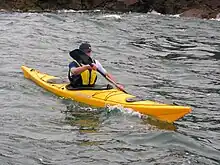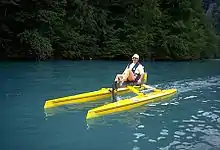Human-powered watercraft
Human-powered watercraft are watercraft propelled only by human power, instead of being propelled by wind power (via one or more sails) or an engine.
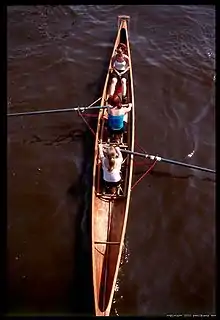
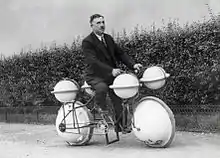
The three main methods of exerting human power are:
- directly from the hands or feet, sometimes aided by swimfins;
- through hand-operated oars, paddles, or poles, or;
- through the feet with pedals, crankset or treadle.[1]
While most human-powered watercraft use buoyancy to maintain their position relative to the surface of the water, a few, such as human-powered hydrofoils and human-powered submarines, use hydrofoils, either alone or in addition to buoyancy.
Oared craft
Oars are held at one end, have a blade on the other end, and pivot in between in oarlocks.
Oared craft include:
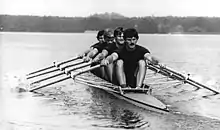
Using oars in pairs, with one hand on each oar, is two-oar sculling. The oars may also be called sculls.[2]
Two-oared sculled craft include:
- Adirondack guideboat
- Banks dory, Gloucester dory, and McKenzie River dory
- Dinghy
- Sampans rowed by foot in Ninh Bình Province of northern Vietnam.[3]
- Scull, Single scull, Double scull, Quad scull, and Octuple scull
- Skiff
- Row boat
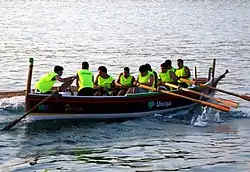
Using oars individually, with both hands on a single oar, is sweep or sweep-oar rowing.[2] In this case the rowers are usually paired so that there is an oar on each side of the boat.
Sweep-oared craft include:
- Coxless pair, Coxed pair, Coxless four, Coxed four, and Eight
- Galley, Dromon, Trainera, and Trireme
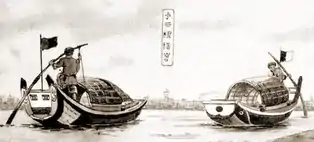
Moving a single stern-mounted oar from side to side, while changing the angle of the blade so as to generate forward thrust on both strokes, is single-oar sculling.[4]
Single-oar sculled craft include:
Paddlecraft
Paddled watercraft, or paddlecraft, uses one or more handheld paddles, each with a widened blade on one or both ends, to push water and propel the watercraft.. Commonly seen paddlecrafts include:
- Canoe, Outrigger canoe, Hasamibako bune,[5][6][7] Umiak, Waka, Pirogue, Shikara, Dragon boat, and Dugout
- Kayak, Sea kayak, Flyak, and Baidarka
- Coracle, Tarai-bune
- Paddleboard
Pedaled craft
Pedals are attached to a crank and propelled in circles, or to a treadle and reciprocated, with the feet. The collected power is then transferred to the water with a paddle wheel, flippers,[8][9][10] or to the air or water with a propeller.
Pedaled craft include:
Poled craft
A pole is held with both hands and used to push against the bottom.
Poled craft include:
Gallery
 Hand paddling surfboards
Hand paddling surfboards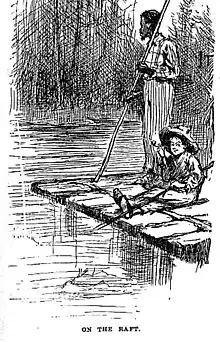 Polling a raft
Polling a raft Sculling a gondola
Sculling a gondola Paddling an umiak
Paddling an umiak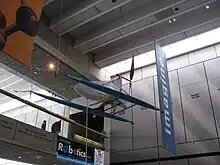 Decavitator, the world's fastest human-powered watercraft, is a pedal-powered hydrofoil
Decavitator, the world's fastest human-powered watercraft, is a pedal-powered hydrofoil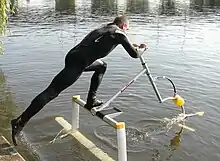 Starting an AquaSkipper hydrofoil
Starting an AquaSkipper hydrofoil Woman rowing sampan with her feet in Ninh Bình Province of northern Vietnam
Woman rowing sampan with her feet in Ninh Bình Province of northern Vietnam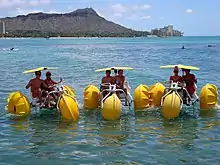 Human powered aqua-cycle water trikes in the Pacific Ocean with Diamond Head, Hawaii in the background.
Human powered aqua-cycle water trikes in the Pacific Ocean with Diamond Head, Hawaii in the background. race in a wooden sow trough (ge: Sautrogrennen) in Bavaria, Germany (2012)
race in a wooden sow trough (ge: Sautrogrennen) in Bavaria, Germany (2012)
See also
References
- Wilson, David Gordon; Schmidt, Theodor; et al. (May 2020). Bicycling Science (4th paperback ed.). Cambridge, MA: The MIT Press.
- "Sweep vs. Sculling". Virginia Boat Club. Archived from the original on 2011-08-24. Retrieved 2011-07-27.
- Matthew Pike (January 30, 2018). "How Vietnamese Guides Row With Their Feet". TheCulturalTrip.com. Retrieved 2018-10-12.
They row with their feet. As Mrs. Gấm puts it: "Rowing boat by feet is much quicker and less exhausting than by hands."
- Joseph Needham, Colin A. Ronan (1978). The Shorter Science and Civilisation in China. Cambridge University Press. ISBN 9780521315609. Retrieved 2011-07-27.
- https://books.google.co.uk/books?id=0W_SAQAAQBAJ&pg=PT375&lpg=PT375&dq=Hasamibako+bune&source=bl&ots=3eA22kXJ_l&sig=ACfU3U14tGhX3MP_g-Gl8pX6RCWqINuFNg&hl=en&sa=X&ved=2ahUKEwjBhryij4uCAxVwQ0EAHRr4A9I4ChDoAXoECAIQAw#v=onepage&q&f=false
- https://archive.org/stream/JohnLoftyWisemanSASSurvivalHandbookTheUltimateGuideToSurvivingAnywhereWilliamMorrow2014/ebooks/Antony%20Cummins%2C%20Yoshie%20Minami-The%20Book%20of%20Ninja_%20The%20Bansenshukai%20-%20Japan%27s%20Premier%20Ninja%20Manual-Watkins%20Publishing%20%282013%29_djvu.txt
- https://www.kogakure.de/en/water-tools/
- Mike Hanlon (June 4, 2004). "Hobie Pedal Kayak". GizMag. Retrieved 2015-10-22.
The sturdily constructed pedal/flipper mechanism operates like a penguin's fins - swinging laterally underneath the hull as you pedal.
- T. Edward Nickens (Mar 8, 2010). "How to Catch Big Game Fish—From a Kayak". Popular Mechanics. Retrieved 2015-10-22.
It's outfitted with the MirageDrive propulsion system, a pedal-powered pair of flexible fins that function as oscillating foils—much like penguin and sea-turtle flippers.
- "Pedal-powered paddles a relaxing way to explore". The Daily Telegraph. Oct 30, 2008. Retrieved 2015-10-22.
Instead of a conventional paddle, these kayaks can be powered by a foot-pedal system which drives two under-keel fins. Inspired by penguin flippers, the fins swing side to side.
- Charlie Sorrel (Oct 19, 2010). "Pedal Powered Submarine Dives to 20-Feet". Wired. Retrieved 2015-10-22.
The Scubster is an underwater bike, a pedal powered submarine with twin propellors [sic] that push it through the water at a speedy 5mph.
- Timon Singh (Aug 25, 2010). "French Engineers Design a Pedal-Powered Submarine". Inhabitat. Retrieved 2015-10-22.
First there was the bicycle, then the pedalo boat, then the pedal-powered aircraft — and now, thanks to a team of French engineers, the world has the pedal-powered submarine.

